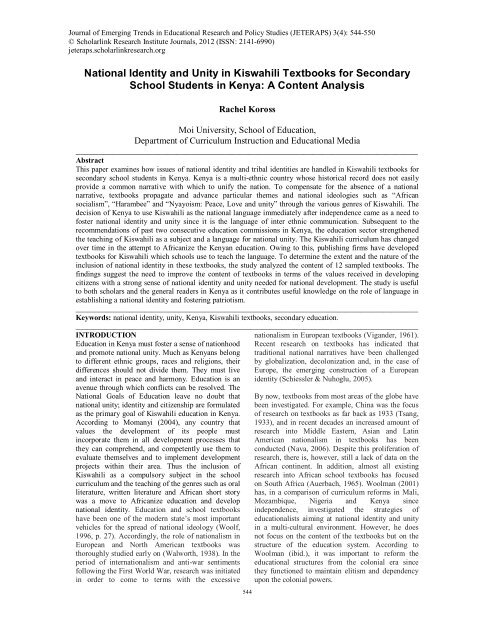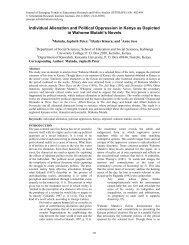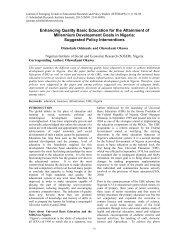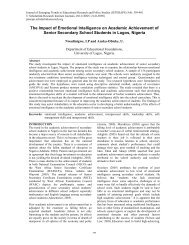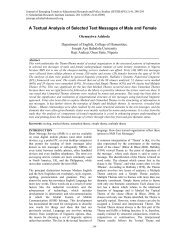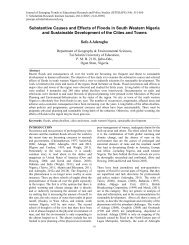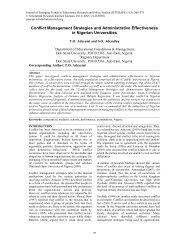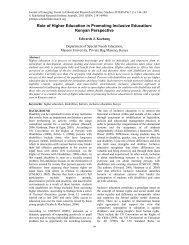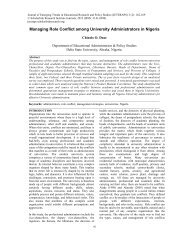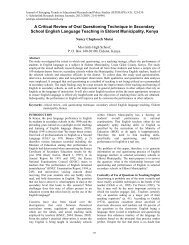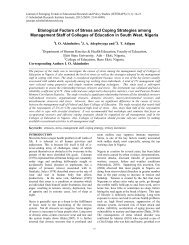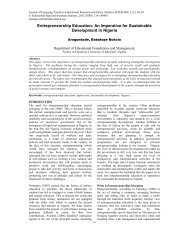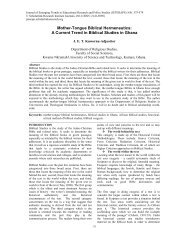National Identity and Unity in Kiswahili Textbooks for Secondary ...
National Identity and Unity in Kiswahili Textbooks for Secondary ...
National Identity and Unity in Kiswahili Textbooks for Secondary ...
You also want an ePaper? Increase the reach of your titles
YUMPU automatically turns print PDFs into web optimized ePapers that Google loves.
Journal of Emerg<strong>in</strong>g Trends <strong>in</strong> Educational Research <strong>and</strong> Policy Studies (JETERAPS) 3(4): 544-550<br />
Journal © Scholarl<strong>in</strong>k of Emerg<strong>in</strong>g Research Trends Institute <strong>in</strong> Educational Journals, 2012 Research (ISSN: <strong>and</strong> 2141-6990) Policy Studies (JETERAPS) 3(4):544-550 (ISSN:2141-6990)<br />
jeteraps.scholarl<strong>in</strong>kresearch.org<br />
<strong>National</strong> <strong>Identity</strong> <strong>and</strong> <strong>Unity</strong> <strong>in</strong> <strong>Kiswahili</strong> <strong>Textbooks</strong> <strong>for</strong> <strong>Secondary</strong><br />
School Students <strong>in</strong> Kenya: A Content Analysis<br />
Rachel Koross<br />
Moi University, School of Education,<br />
Department of Curriculum Instruction <strong>and</strong> Educational Media<br />
___________________________________________________________________________<br />
Abstract<br />
This paper exam<strong>in</strong>es how issues of national identity <strong>and</strong> tribal identities are h<strong>and</strong>led <strong>in</strong> <strong>Kiswahili</strong> textbooks <strong>for</strong><br />
secondary school students <strong>in</strong> Kenya. Kenya is a multi-ethnic country whose historical record does not easily<br />
provide a common narrative with which to unify the nation. To compensate <strong>for</strong> the absence of a national<br />
narrative, textbooks propagate <strong>and</strong> advance particular themes <strong>and</strong> national ideologies such as “African<br />
socialism”, “Harambee” <strong>and</strong> “Nyayoism: Peace, Love <strong>and</strong> unity” through the various genres of <strong>Kiswahili</strong>. The<br />
decision of Kenya to use <strong>Kiswahili</strong> as the national language immediately after <strong>in</strong>dependence came as a need to<br />
foster national identity <strong>and</strong> unity s<strong>in</strong>ce it is the language of <strong>in</strong>ter ethnic communication. Subsequent to the<br />
recommendations of past two consecutive education commissions <strong>in</strong> Kenya, the education sector strengthened<br />
the teach<strong>in</strong>g of <strong>Kiswahili</strong> as a subject <strong>and</strong> a language <strong>for</strong> national unity. The <strong>Kiswahili</strong> curriculum has changed<br />
over time <strong>in</strong> the attempt to Africanize the Kenyan education. Ow<strong>in</strong>g to this, publish<strong>in</strong>g firms have developed<br />
textbooks <strong>for</strong> <strong>Kiswahili</strong> which schools use to teach the language. To determ<strong>in</strong>e the extent <strong>and</strong> the nature of the<br />
<strong>in</strong>clusion of national identity <strong>in</strong> these textbooks, the study analyzed the content of 12 sampled textbooks. The<br />
f<strong>in</strong>d<strong>in</strong>gs suggest the need to improve the content of textbooks <strong>in</strong> terms of the values received <strong>in</strong> develop<strong>in</strong>g<br />
citizens with a strong sense of national identity <strong>and</strong> unity needed <strong>for</strong> national development. The study is useful<br />
to both scholars <strong>and</strong> the general readers <strong>in</strong> Kenya as it contributes useful knowledge on the role of language <strong>in</strong><br />
establish<strong>in</strong>g a national identity <strong>and</strong> foster<strong>in</strong>g patriotism.<br />
__________________________________________________________________________________________<br />
Keywords: national identity, unity, Kenya, <strong>Kiswahili</strong> textbooks, secondary education.<br />
__________________________________________________________________________________________<br />
INTRODUCTION<br />
Education <strong>in</strong> Kenya must foster a sense of nationhood<br />
<strong>and</strong> promote national unity. Much as Kenyans belong<br />
to different ethnic groups, races <strong>and</strong> religions, their<br />
differences should not divide them. They must live<br />
<strong>and</strong> <strong>in</strong>teract <strong>in</strong> peace <strong>and</strong> harmony. Education is an<br />
avenue through which conflicts can be resolved. The<br />
<strong>National</strong> Goals of Education leave no doubt that<br />
national unity; identity <strong>and</strong> citizenship are <strong>for</strong>mulated<br />
as the primary goal of <strong>Kiswahili</strong> education <strong>in</strong> Kenya.<br />
Accord<strong>in</strong>g to Momanyi (2004), any country that<br />
values the development of its people must<br />
<strong>in</strong>corporate them <strong>in</strong> all development processes that<br />
they can comprehend, <strong>and</strong> competently use them to<br />
evaluate themselves <strong>and</strong> to implement development<br />
projects with<strong>in</strong> their area. Thus the <strong>in</strong>clusion of<br />
<strong>Kiswahili</strong> as a compulsory subject <strong>in</strong> the school<br />
curriculum <strong>and</strong> the teach<strong>in</strong>g of the genres such as oral<br />
literature, written literature <strong>and</strong> African short story<br />
was a move to Africanize education <strong>and</strong> develop<br />
national identity. Education <strong>and</strong> school textbooks<br />
have been one of the modern state’s most important<br />
vehicles <strong>for</strong> the spread of national ideology (Woolf,<br />
1996, p. 27). Accord<strong>in</strong>gly, the role of nationalism <strong>in</strong><br />
European <strong>and</strong> North American textbooks was<br />
thoroughly studied early on (Walworth, 1938). In the<br />
period of <strong>in</strong>ternationalism <strong>and</strong> anti-war sentiments<br />
follow<strong>in</strong>g the First World War, research was <strong>in</strong>itiated<br />
<strong>in</strong> order to come to terms with the excessive<br />
544<br />
nationalism <strong>in</strong> European textbooks (Vig<strong>and</strong>er, 1961).<br />
Recent research on textbooks has <strong>in</strong>dicated that<br />
traditional national narratives have been challenged<br />
by globalization, decolonization <strong>and</strong>, <strong>in</strong> the case of<br />
Europe, the emerg<strong>in</strong>g construction of a European<br />
identity (Schiessler & Nuhoglu, 2005).<br />
By now, textbooks from most areas of the globe have<br />
been <strong>in</strong>vestigated. For example, Ch<strong>in</strong>a was the focus<br />
of research on textbooks as far back as 1933 (Tsang,<br />
1933), <strong>and</strong> <strong>in</strong> recent decades an <strong>in</strong>creased amount of<br />
research <strong>in</strong>to Middle Eastern, Asian <strong>and</strong> Lat<strong>in</strong><br />
American nationalism <strong>in</strong> textbooks has been<br />
conducted (Nava, 2006). Despite this proliferation of<br />
research, there is, however, still a lack of data on the<br />
African cont<strong>in</strong>ent. In addition, almost all exist<strong>in</strong>g<br />
research <strong>in</strong>to African school textbooks has focused<br />
on South Africa (Auerbach, 1965). Woolman (2001)<br />
has, <strong>in</strong> a comparison of curriculum re<strong>for</strong>ms <strong>in</strong> Mali,<br />
Mozambique, Nigeria <strong>and</strong> Kenya s<strong>in</strong>ce<br />
<strong>in</strong>dependence, <strong>in</strong>vestigated the strategies of<br />
educationalists aim<strong>in</strong>g at national identity <strong>and</strong> unity<br />
<strong>in</strong> a multi-cultural environment. However, he does<br />
not focus on the content of the textbooks but on the<br />
structure of the education system. Accord<strong>in</strong>g to<br />
Woolman (ibid.), it was important to re<strong>for</strong>m the<br />
educational structures from the colonial era s<strong>in</strong>ce<br />
they functioned to ma<strong>in</strong>ta<strong>in</strong> elitism <strong>and</strong> dependency<br />
upon the colonial powers.
Journal of Emerg<strong>in</strong>g Trends <strong>in</strong> Educational Research <strong>and</strong> Policy Studies (JETERAPS) 3(4):544-550 (ISSN:2141-6990)<br />
The lack of research on nationalism <strong>in</strong> African<br />
textbooks is probably partly a result of the fact that<br />
African states are difficult to fit <strong>in</strong>to the st<strong>and</strong>ard<br />
model of nation-states. It may be argued that it is<br />
difficult to f<strong>in</strong>d states anywhere <strong>in</strong> the world where<br />
the population shares a common history, language<br />
<strong>and</strong> culture, but African nations offer more extreme<br />
exceptions as they are often heavily ethnically<br />
fragmented constructions of recent European<br />
imperialism. Strengthened national identities are but<br />
one possible avenue of future development s<strong>in</strong>ce<br />
tribal <strong>and</strong> Pan-African identities appear to offer<br />
equally viable <strong>and</strong> relevant alternatives. Certa<strong>in</strong>ly, if<br />
we want to more fully underst<strong>and</strong> phenomena such as<br />
nationalism <strong>and</strong> the role of education <strong>in</strong> national<br />
identity <strong>and</strong> unity, it is richly <strong>in</strong><strong>for</strong>mative to focus on<br />
the extreme circumstances of Africa, where<br />
nationalism is under pressure from other potent,<br />
collective identities. Indeed, the extent to which the<br />
relative weakness of national identity <strong>in</strong> Africa makes<br />
the educational system’s role <strong>in</strong> nation-build<strong>in</strong>g even<br />
more crucial than <strong>in</strong> other countries is an area worthy<br />
of close <strong>in</strong>vestigation.<br />
In the African perspective, schools are shaped by the<br />
society <strong>and</strong> they reflect the societal cultural<br />
characteristics, needs <strong>and</strong> values. Thus they are<br />
<strong>in</strong>struments of society regardless of whose <strong>in</strong>terests<br />
or needs are served <strong>and</strong> regardless of how society is<br />
def<strong>in</strong>ed. The major <strong>in</strong>structional resources <strong>in</strong> Kenyan<br />
secondary schools are textbooks. The knowledge<br />
packaged <strong>in</strong>to ‘facts’ is taken to be conta<strong>in</strong>ed <strong>in</strong><br />
textbooks <strong>and</strong> transmitted by teachers who tend to<br />
view these same textbooks as reflect<strong>in</strong>g the beg<strong>in</strong>n<strong>in</strong>g<br />
<strong>and</strong> the end of the entire human stock of<br />
accumulated facts. <strong>Textbooks</strong> are also characterized<br />
by uni<strong>for</strong>mity of message throughout national school<br />
systems <strong>and</strong> their availability is <strong>in</strong>creas<strong>in</strong>gly taken to<br />
be the most consistent <strong>and</strong> positive determ<strong>in</strong>ant of<br />
academic achievement. Text books are also good<br />
<strong>in</strong>dicators of ‘core values’ which the country’s<br />
leadership wishes to <strong>in</strong>culcate <strong>in</strong> its young<br />
generations. They are conceived as def<strong>in</strong><strong>in</strong>g attitudes,<br />
social mores, expectations, values <strong>and</strong> behaviour<br />
patterns that are ‘congruent’ to the ideal citizens as<br />
def<strong>in</strong>ed by leadership’s world view <strong>and</strong> ideological<br />
orientation.<br />
<strong>Textbooks</strong> <strong>for</strong>m the ma<strong>in</strong> medium of <strong>in</strong>struction <strong>and</strong><br />
learn<strong>in</strong>g resource <strong>in</strong> most parts of post-colonial<br />
African countries (Rotich, 2004) yet there are no<br />
studies to determ<strong>in</strong>e whether or not Kenyan<br />
secondary school textbooks <strong>and</strong> teachers’ guides<br />
address issues core to identity <strong>and</strong> equip students<br />
with the necessary skills to analyze <strong>and</strong> evaluate<br />
these issues. Historically, the Kenyan government has<br />
been keen to control textbook publication <strong>for</strong> schools<br />
<strong>in</strong> order to meet the cultural needs of Kenyan<br />
students (Rotich, 2004). There<strong>for</strong>e, textbooks,<br />
particularly published by a state-owned publisher,<br />
may offer a clear description on how the state fosters<br />
its sense of nationhood through particular content <strong>and</strong><br />
skills. Be<strong>for</strong>e <strong>and</strong> immediately after <strong>in</strong>dependence,<br />
mult<strong>in</strong>ational publishers dom<strong>in</strong>ated textbook<br />
publication <strong>in</strong> Kenya (Ogechi & Ogechi, 2002).<br />
However, with the <strong>in</strong>troduction of the 8-4-4 system<br />
of education <strong>in</strong> 1985, two government publishers, the<br />
Kenya Literature Bureau (KLB) <strong>and</strong> the Jomo<br />
Kenyatta Foundation (JKF), took over most of the<br />
school textbook publication. Until 1997, school<br />
textbook publication <strong>in</strong> Kenya was dom<strong>in</strong>ated by<br />
KLB <strong>and</strong> JKF, to ensure that textbooks’ content was<br />
culturally relevant to the Kenyan students (Ogechi &<br />
Ogechi, 2002). Prior to the year 1999, the M<strong>in</strong>istry of<br />
Education categorized school textbooks <strong>in</strong>to two:<br />
core <strong>and</strong> supplementary.<br />
The core textbooks consisted of textbooks that were<br />
written by the Kenya Institute of Education (KIE),<br />
<strong>and</strong> published by KLB <strong>and</strong> JKF whereas the<br />
supplementary were textbooks published by nongovernment<br />
publishers (Rotich, 2000). With the<br />
liberalization of markets, the Kenyan government<br />
allowed other publishers to equally compete <strong>for</strong> their<br />
textbooks’ adoption. However, <strong>for</strong> the textbooks to<br />
be approved <strong>for</strong> use <strong>in</strong> Kenyan schools, the<br />
publishers had to write their textbooks follow<strong>in</strong>g the<br />
guidance of the syllabi produced by the M<strong>in</strong>istry of<br />
Education through the KIE. These textbooks must<br />
also be approved by the M<strong>in</strong>istry of Education.<br />
Despite government liberalization of textbook<br />
production, Rotich (ibid.) notes that a group of<br />
consultants approved by the M<strong>in</strong>istry of Education<br />
found that the government’s control of textbook<br />
production was still <strong>in</strong> place. This was confirmed by<br />
the highest percentage of school textbooks, published<br />
by KLB <strong>and</strong> JKF on the market. Currently, Kenya<br />
has two state-owned, a number of local <strong>and</strong><br />
mult<strong>in</strong>ational publishers. The M<strong>in</strong>istry of Education<br />
publishes a list of recommended textbooks every year<br />
<strong>and</strong> distributes it to all schools. Schools are then<br />
required to choose from a list of recommended<br />
textbooks. This choice usually depends on the content<br />
<strong>and</strong> the price among other factors. For our study,<br />
three series of <strong>Kiswahili</strong> recommended textbooks<br />
were r<strong>and</strong>omly selected <strong>for</strong> content analysis <strong>and</strong> a<br />
total of twelve textbooks were sampled. The paper<br />
exam<strong>in</strong>es the extent <strong>and</strong> the nature of the <strong>in</strong>clusion of<br />
issues of national identity <strong>and</strong> national unity <strong>in</strong> the<br />
selected <strong>Kiswahili</strong> recommended textbooks not<strong>in</strong>g<br />
that <strong>Kiswahili</strong> is a core <strong>and</strong> compulsory subject <strong>in</strong><br />
Kenyan secondary schools.<br />
The core objectives of the study were: to determ<strong>in</strong>e<br />
the extent to which <strong>Kiswahili</strong> textbooks <strong>in</strong>clude<br />
issues of national unity <strong>and</strong> identity <strong>in</strong> its content, <strong>and</strong><br />
to establish the nature of <strong>in</strong>clusion of issues of<br />
national unity <strong>and</strong> identity <strong>in</strong> the <strong>Kiswahili</strong> textbooks.<br />
The study offers new <strong>in</strong>sights <strong>in</strong>to how national<br />
545
Journal of Emerg<strong>in</strong>g Trends <strong>in</strong> Educational Research <strong>and</strong> Policy Studies (JETERAPS) 3(4):544-550 (ISSN:2141-6990)<br />
identity is constructed <strong>in</strong> school textbooks <strong>in</strong> an<br />
African country.<br />
Theoretical Issues on Textbook Content <strong>and</strong><br />
<strong>National</strong> <strong>Identity</strong><br />
The theory underp<strong>in</strong>n<strong>in</strong>g the study was Smith’s<br />
model (1986). The most renowned theorists of<br />
nationalism, Anderson <strong>and</strong> Smith, developed<br />
compet<strong>in</strong>g theories of how national identity arises.<br />
Anderson (2006) emphasizes the nations’ constructed<br />
nature, regard<strong>in</strong>g them as products of <strong>in</strong>tentional<br />
political attempts at nation-build<strong>in</strong>g. Smith (1986)<br />
believes that nation-build<strong>in</strong>g requires the preexistence<br />
of a core “ethnie” who share a common<br />
denom<strong>in</strong>ation, a myth of orig<strong>in</strong>, a common history, a<br />
dist<strong>in</strong>ct common culture, a territory <strong>and</strong> a sense of<br />
solidarity. Some critics have argued that Smith’s<br />
model is not applicable to Africa, where a central<br />
“ethnie” does not exist <strong>in</strong> most states (Palmberg,<br />
2009). However, Smith frequently refers to the<br />
cont<strong>in</strong>ent <strong>in</strong> his writ<strong>in</strong>gs such as when he expla<strong>in</strong>s the<br />
dist<strong>in</strong>ction between “full” <strong>and</strong> “depleted” ethnies.<br />
The first category is represented by Ethiopia, rich <strong>in</strong><br />
myths <strong>and</strong> history, while depleted ethnies like Kenya<br />
<strong>and</strong> Tanzania lack traditions of a common ancestry.<br />
S<strong>in</strong>ce, <strong>in</strong> the case of these countries, ethnicity could<br />
not <strong>for</strong>m the basis of national unity, they have<br />
attempted national identity through the creation of<br />
one-party states <strong>and</strong> national language which Smith<br />
describes as a <strong>for</strong>m of political religion (Smith, 1986,<br />
p. 11). Smith (1986, p. 148) describes Kenya as a<br />
depleted ethnie.<br />
It is this heterogeneity <strong>in</strong> Kenya lead<strong>in</strong>g to diversity<br />
<strong>in</strong> language, dialects <strong>and</strong> culture that led <strong>Kiswahili</strong> to<br />
ga<strong>in</strong> the status of national language <strong>and</strong> a language<br />
<strong>for</strong> unification after <strong>in</strong>dependence. Adopt<strong>in</strong>g Smith’s<br />
model <strong>for</strong> our study meant that <strong>Kiswahili</strong> becomes<br />
the ethnie <strong>in</strong> the study <strong>and</strong> can be used to promote<br />
nationalism. This unify<strong>in</strong>g aspect is also echoed <strong>in</strong><br />
the <strong>National</strong> goals of education which emphasize that<br />
Education <strong>in</strong> Kenya must foster a sense of nationhood<br />
<strong>and</strong> promote national unity. Much as Kenyans belong<br />
to different ethnic groups, races <strong>and</strong> religions, their<br />
differences should not divide them. They must live<br />
<strong>and</strong> <strong>in</strong>teract <strong>in</strong> peace <strong>and</strong> harmony. Education is an<br />
avenue through which conflicts can be prevented or<br />
elim<strong>in</strong>ated.<br />
The <strong>National</strong> Goals of Education leave no doubt that<br />
national identity <strong>and</strong> unity are <strong>for</strong>mulated as the<br />
primary goal of <strong>Kiswahili</strong> education. Thus this paper<br />
exam<strong>in</strong>es the extent <strong>and</strong> ways <strong>in</strong> which textbooks<br />
contribute to external <strong>and</strong> <strong>in</strong>ternal <strong>for</strong>mations of<br />
tribal, cultural <strong>and</strong> national identities.<br />
MATERIALS AND METHODS<br />
The specific research questions were addressed<br />
through qualitative content analysis of twelve<br />
<strong>Kiswahili</strong> students’ textbooks. Generally,<br />
Krippendorff (2004) def<strong>in</strong>es content analysis as “a<br />
research technique <strong>for</strong> mak<strong>in</strong>g replicable <strong>and</strong> valid<br />
<strong>in</strong>ferences from texts (or other mean<strong>in</strong>gful matter) to<br />
the context of their use” (p. 18). Hsieh <strong>and</strong> Shannon<br />
(2005) offer an elaborate def<strong>in</strong>ition of qualitative<br />
content analysis as “a research method <strong>for</strong> subjective<br />
<strong>in</strong>terpretation of content of text data through the<br />
systematic classification process of cod<strong>in</strong>g <strong>and</strong><br />
identify<strong>in</strong>g themes or patterns” (p. 1278).<br />
Content analysis has an advantage of produc<strong>in</strong>g data<br />
that is not obtrusive (Insch et al., 1997; Krippendorff,<br />
2004). There<strong>for</strong>e, the author used content analysis to<br />
exam<strong>in</strong>e data that was produced without the<br />
respondent’s or a writer’s prior knowledge that the<br />
<strong>in</strong><strong>for</strong>mation could be used as research data. The<br />
unobtrusive nature of content analysis reduces a<br />
researcher’s biases (Insch et al., 1997). In addition,<br />
content analysis is valued <strong>for</strong> its ability to evaluate<br />
the presentation of a certa<strong>in</strong> issue <strong>in</strong> a large number<br />
of texts (McKee, 2003; Carley, 1993). Content<br />
analysis can generate analysis categories from an<br />
exist<strong>in</strong>g theory or available research (Hsieh &<br />
Shannon, 2005; Krippendorff, 2004).<br />
LIMITATIONS OF THE STUDY<br />
S<strong>in</strong>ce this is a grey area, lack of literature on the topic<br />
of study was a limitation but literature on research<br />
done <strong>in</strong> other related areas <strong>and</strong> subjects were used.<br />
RESULTS AND DISCUSSION<br />
The Extent of Inclusion of Issues of <strong>National</strong> <strong>Unity</strong><br />
<strong>and</strong> <strong>Identity</strong><br />
Content analysis was done on 12 recommended text<br />
books <strong>for</strong> teach<strong>in</strong>g <strong>Kiswahili</strong> <strong>in</strong> Kenyan secondary<br />
schools. The content analysis was done at conceptual<br />
level to ascerta<strong>in</strong> the extent <strong>and</strong> the nature of the<br />
<strong>in</strong>clusion of issues of national identity <strong>and</strong> unity <strong>in</strong><br />
the <strong>Kiswahili</strong> course textbooks. At first words <strong>and</strong><br />
phrases that connote national unity <strong>and</strong> identity were<br />
sampled. These sampled words were: umoja (unity),<br />
kuleta jamii pamoja (to br<strong>in</strong>g the society together),<br />
kusuluhisha matatizo katika jamii (to resolve<br />
problems <strong>in</strong> the society), kuondoa uhasama kati ya<br />
wanajamii (to discourage conflict among members of<br />
the society), Kushirikiana kwa pamoja<br />
(togetherness), kujivunia nchi yako (to be proud of<br />
your country), uzalendo (patriotism). Any other<br />
words that brought <strong>in</strong> the concepts of national unity<br />
<strong>and</strong> identity were also considered.<br />
The presence of these words <strong>and</strong> the themes that<br />
attributed to national unity <strong>and</strong> identity were<br />
considered as topics <strong>for</strong> national unity <strong>and</strong> identity.<br />
Topics that did not have these words <strong>in</strong> their content<br />
or their themes did not attribute to national unity <strong>and</strong><br />
identity <strong>and</strong> were considered as topics that were not<br />
<strong>for</strong> national unity <strong>and</strong> identity. The data on Table 1<br />
shows the f<strong>in</strong>d<strong>in</strong>gs of this content analysis.<br />
546
Journal of Emerg<strong>in</strong>g Trends <strong>in</strong> Educational Research <strong>and</strong> Policy Studies (JETERAPS) 3(4):544-550 (ISSN:2141-6990)<br />
Table 1: Topics <strong>for</strong> <strong>and</strong> those not <strong>for</strong> <strong>National</strong> <strong>Unity</strong><br />
<strong>and</strong> <strong>Identity</strong> <strong>in</strong> <strong>Kiswahili</strong> Recommended Course<br />
Books<br />
TEXBOOK<br />
No. of topics No. of topics Total<br />
<strong>for</strong> national not <strong>for</strong> national<br />
unity <strong>and</strong> unity <strong>and</strong><br />
identity identity<br />
07(6%) 105(94%) 112(100%)<br />
Chemichemi za<br />
<strong>Kiswahili</strong> 1<br />
Chemichemi za 11(9%) 107(91%) 118(100%)<br />
<strong>Kiswahili</strong> 2<br />
Chemichemi za 29(25%) 86(75%) 115(100%)<br />
<strong>Kiswahili</strong> 3<br />
Chemichemi za 23(23%) 77(77%) 100(100%)<br />
<strong>Kiswahili</strong> 4<br />
Total 70(16%) 375(84%) 445(100%)<br />
<strong>Kiswahili</strong> kitukuzwe 1 09(13%) 60(87%) 69(100%)<br />
<strong>Kiswahili</strong> kitukuzwe 2 10(14%) 59(86%) 69(100%)<br />
<strong>Kiswahili</strong> kitukuzwe 3 11(11%) 92(89%) 103(100%)<br />
<strong>Kiswahili</strong> kitukuzwe 4 23(21%) 87(79%) 110(100%)<br />
Total 53(15%) 298(85%) 351(100%)<br />
Johari ya <strong>Kiswahili</strong> 1 12(10%) 111(90%) 123(100%)<br />
Johari ya <strong>Kiswahili</strong> 2 14(11%) 109(89%) 123(100%)<br />
Johari ya <strong>Kiswahili</strong> 3 26(20%) 104(80%) 130(100%)<br />
Johari ya <strong>Kiswahili</strong> 4 18(15%) 102(85%) 120(100%)<br />
Total 70(14%) 426(86%) 496(100%)<br />
The data <strong>in</strong>dicates that very few topics <strong>in</strong> the<br />
<strong>Kiswahili</strong> course books have content on national<br />
unity <strong>and</strong> identity. A total of 70(16%) topics were <strong>for</strong><br />
national unity <strong>and</strong> identity <strong>in</strong> the Chemichemi za<br />
Kisawhili textbook where as 375(84%) topics had no<br />
themes on national unity <strong>and</strong> identity. Fifty-three<br />
(15%) topics <strong>in</strong> <strong>Kiswahili</strong> Kitukuzwe were <strong>for</strong><br />
national unity <strong>and</strong> identity while 298(85%) topics<br />
were not. In Johari ya <strong>Kiswahili</strong>, a total of 70(14%)<br />
topics were <strong>for</strong> national unity <strong>and</strong> identity whereas<br />
426(86%) topics had no themes on national unity <strong>and</strong><br />
identity.<br />
The analyzed data also <strong>in</strong>dicated that the content <strong>in</strong><br />
the various <strong>Kiswahili</strong> genres do not advocate <strong>for</strong><br />
national unity <strong>and</strong> identity. For example, the writ<strong>in</strong>g<br />
skills section of <strong>Kiswahili</strong> only highlighted on the<br />
major writ<strong>in</strong>g skills <strong>and</strong> had no aspects of national<br />
identity <strong>and</strong> unity. The grammar part of the language<br />
was basically on grammatical rules <strong>and</strong> had noth<strong>in</strong>g<br />
to emphasize on national unity <strong>and</strong> identity. The only<br />
aspects that were noticed <strong>in</strong> this section of the<br />
language were the diverse examples on the various<br />
nouns/names that were used as examples <strong>in</strong> various<br />
sentences. It was evident that the nouns/names that<br />
were used <strong>in</strong> all the 12 textbooks were representative<br />
of the diverse communities <strong>in</strong> Kenya. The content <strong>in</strong><br />
the oral literature part also catered <strong>for</strong> the diverse<br />
cultures <strong>in</strong> Kenya <strong>in</strong> all the sampled text books<br />
though not all Kenyan communities were captured.<br />
The bias was on the majority <strong>and</strong> m<strong>in</strong>ority ethnic<br />
groups. Most of the examples were from the majority<br />
groups <strong>for</strong> example topics on legends covered the<br />
heroes from the majority ethnic groups, like Lw<strong>and</strong>a<br />
Magere (Luo), Nabongo Mumia (Luhya), Mekatilili<br />
(Meru) among others. In certa<strong>in</strong> series of books, <strong>for</strong><br />
example Chemichemi za <strong>Kiswahili</strong>, there were no<br />
examples from some m<strong>in</strong>ority groups like the Boran,<br />
Rendile, <strong>and</strong> Turkana among others.<br />
There<strong>for</strong>e, there is need <strong>for</strong> African schools to<br />
acknowledge diversity <strong>in</strong> African societies as strength<br />
<strong>and</strong> not as a threat to national unity (Berman et al.,<br />
2004; Ntarangwi, 2003; Dei et al., 2006; Woolman,<br />
2001). Dei et al. (2006) argue that there is scarcity of<br />
<strong>in</strong><strong>for</strong>mation on how schools <strong>in</strong> African countries can<br />
serve diverse students <strong>in</strong> an equitable way. Accord<strong>in</strong>g<br />
to Dei et al. (ibid.), recogniz<strong>in</strong>g <strong>and</strong> respect<strong>in</strong>g<br />
differences will ensure long last<strong>in</strong>g solutions to some<br />
of the social <strong>and</strong> political problems <strong>in</strong> Africa. With<br />
reference to Ghana, a country similar to most African<br />
countries <strong>in</strong> terms of multi-ethnic <strong>and</strong> multil<strong>in</strong>gual<br />
character, Dei et al. (2006) observe that ethnicity still<br />
privileges some groups over others <strong>in</strong> terms of access<br />
to educational opportunity. They there<strong>for</strong>e argue that<br />
emphasiz<strong>in</strong>g nation-build<strong>in</strong>g without consider<strong>in</strong>g<br />
differences can make the dom<strong>in</strong>ant group fail to<br />
admit its privileged status.<br />
Woolman (2001) admits that national unity is still an<br />
important goal <strong>for</strong> African countries. Accord<strong>in</strong>g to<br />
Woolman (ibid.), national unity can be achieved<br />
through education that teaches “African economics,<br />
geography, culture <strong>and</strong> history, cultural heritage of<br />
dance, music <strong>and</strong> visual arts, literature, <strong>and</strong> natural<br />
resources” (p. 41). Woolman (ibid.) notes further that<br />
social studies should balance the underst<strong>and</strong><strong>in</strong>g of<br />
different cultures <strong>and</strong> the acknowledgment of<br />
similarities among the cultures <strong>in</strong> order to facilitate<br />
unity. Oral literature may <strong>in</strong>clude genres such poetry,<br />
legends, praise songs, <strong>and</strong> narratives. Oka<strong>for</strong> (2004)<br />
asserts that African traditional/pre-colonial society<br />
conta<strong>in</strong>ed <strong>for</strong>ms of civic education that were<br />
practiced through the use of various <strong>for</strong>ms of African<br />
oral literature. Thus the oral literature <strong>in</strong> <strong>Kiswahili</strong><br />
that is taught <strong>in</strong> secondary school can be used to<br />
enhance national identity <strong>and</strong> unity.<br />
What comes out clearly from the data is that schools<br />
should encourage multicultural education because it<br />
is a way of acknowledg<strong>in</strong>g diversity <strong>and</strong> encourag<strong>in</strong>g<br />
social stability among African students. Pai (1990)<br />
has discussed four aims of multicultural education.<br />
First, multicultural education nurtures respect <strong>for</strong>, <strong>and</strong><br />
appreciation of cultural diversity. The appreciation of<br />
different cultures enables us to effectively deal with<br />
our problems by learn<strong>in</strong>g from other cultures.<br />
Secondly, it promotes the <strong>in</strong>herent worth of each<br />
person <strong>and</strong> <strong>in</strong>terest <strong>in</strong> the well-be<strong>in</strong>g of the society.<br />
This second aim is based on the assumption that<br />
people’s identity is rooted <strong>in</strong> their culture. Third,<br />
multicultural education equips us with multicultural<br />
competencies that allow us to function effectively <strong>in</strong><br />
culturally diverse sett<strong>in</strong>gs. Last, multicultural<br />
education is <strong>in</strong>strumental <strong>in</strong> ensur<strong>in</strong>g educational<br />
equity <strong>for</strong> all regardless of ethnicity, race, age or<br />
other exceptionalities. Dei et al. (2006) note that<br />
ethnicity is relevant <strong>in</strong> discuss<strong>in</strong>g education <strong>in</strong> the<br />
African context. With reference to Ghana, Dei et al.<br />
(ibid.) argue that it is problematic <strong>for</strong> students to view<br />
547
Journal of Emerg<strong>in</strong>g Trends <strong>in</strong> Educational Research <strong>and</strong> Policy Studies (JETERAPS) 3(4):544-550 (ISSN:2141-6990)<br />
themselves as Ghanaians without consider<strong>in</strong>g their<br />
ethnic identifications (which is the same <strong>for</strong> Kenyan<br />
students) because focus on national <strong>in</strong>tegration<br />
without consider<strong>in</strong>g ethnic differences blurs the<br />
reality of uneven power relations that exist <strong>in</strong> a<br />
society, which, <strong>in</strong> turn, ma<strong>in</strong>ta<strong>in</strong>s power <strong>in</strong>equalities<br />
among ethnic groups. With the emergence of tribal<br />
conflict <strong>in</strong> Kenya (2007-2008 post election violence),<br />
there is need <strong>for</strong> the government to also emphasize on<br />
issues of national unity <strong>and</strong> identity <strong>in</strong> the<br />
recommended secondary school textbooks. This<br />
suggests that a lot has to be done <strong>in</strong> improv<strong>in</strong>g the<br />
content <strong>in</strong> <strong>Kiswahili</strong> so as to atta<strong>in</strong> the national goal<br />
of education of national unity more so <strong>Kiswahili</strong><br />
be<strong>in</strong>g the national language whose ma<strong>in</strong> purpose <strong>in</strong><br />
education is to enhance national unity.<br />
Current Kenyan policy espouses universal education,<br />
with equal opportunity <strong>for</strong> all. The core goals reflect<br />
traditional values of tra<strong>in</strong><strong>in</strong>g <strong>in</strong> social justice,<br />
morality, <strong>and</strong> responsibility, along with acquisition of<br />
life skills needed <strong>in</strong> the local environment. Modern<br />
policy goals <strong>in</strong>clude national development <strong>and</strong> unity<br />
along with <strong>in</strong>dividual service to the nation. Kenya’s<br />
social diversity has brought a collateral concern <strong>for</strong><br />
preservation of cultural heritage, social justice,<br />
human dignity, political equality <strong>and</strong> multicultural<br />
education. Critical reviews of the 8-4-4 system <strong>in</strong><br />
1990 <strong>and</strong> 1995 resulted <strong>in</strong> recommendations <strong>for</strong><br />
reorganization of content <strong>and</strong> reduction of subjects<br />
due to student overload. A recent high level re<strong>for</strong>m<br />
ef<strong>for</strong>t, the Koech Commission, made various<br />
recommendations. These <strong>in</strong>cluded new ef<strong>for</strong>ts to<br />
build patriotism, national unity, mutual social<br />
responsibility, morality <strong>and</strong> ethical st<strong>and</strong>ards;<br />
education <strong>for</strong> all among others. The report<br />
emphasized on <strong>in</strong>tegration <strong>and</strong> improvement of<br />
content especially <strong>in</strong> <strong>Kiswahili</strong> where topics like oral<br />
literature <strong>and</strong> emerg<strong>in</strong>g issues <strong>in</strong> society were<br />
emphasized. Current policy calls <strong>for</strong> modification of<br />
the 8-4-4 system <strong>and</strong> strengthen<strong>in</strong>g curriculum with<br />
emphasis given to <strong>in</strong>dustrialization, environmental<br />
education, AIDS awareness, gender equity, <strong>and</strong><br />
elim<strong>in</strong>ation of child labour <strong>and</strong> poverty. With the<br />
2007-2008 post election violence, national unity <strong>in</strong><br />
Kenya has been an area of concern <strong>and</strong> has become<br />
an emerg<strong>in</strong>g issue that needs to be addressed <strong>in</strong> all<br />
the sectors of the society. The education process <strong>in</strong><br />
Kenya was adversely affected by the violence <strong>and</strong><br />
hence there is need to <strong>in</strong>tegrate issues of national<br />
unity <strong>and</strong> identity <strong>in</strong> school content so as to educate<br />
Kenyan children <strong>and</strong> citizens on the need of national<br />
unity.<br />
The Nature of Inclusion of Issues of <strong>National</strong><br />
<strong>Identity</strong> <strong>and</strong> <strong>Unity</strong> <strong>in</strong> the <strong>Textbooks</strong><br />
Regard<strong>in</strong>g the nature of representation of these<br />
issues, it was noted that the section on oral skills <strong>and</strong><br />
oral literature had majority of the topics <strong>for</strong> national<br />
unity <strong>and</strong> identity. It was evident <strong>in</strong> oral literature that<br />
there were examples from many cultural communities<br />
<strong>in</strong> Kenya. The books also acknowledged diversity by<br />
not<strong>in</strong>g that Kenya did not have one culture but had as<br />
many cultures as the number of ethnic groups. Oral<br />
literature topics also had short stories, myths,<br />
proverbs <strong>and</strong> say<strong>in</strong>gs with themes that emphasized<br />
peace, unity, patriotism, togetherness, love, <strong>and</strong><br />
community cooperation among other themes that<br />
encourage unity.<br />
The sampled textbooks also discussed national<br />
heroes. It was evident <strong>in</strong> all the sampled books<br />
(<strong>Kiswahili</strong> Kitukuzwe - Kidato cha 2 pg. 60; Kidato<br />
cha 3 pg. 122-123; Kidato cha 4 pg. 125;<br />
Chemichemi za <strong>Kiswahili</strong> - Kidato cha 2 pg. 199;<br />
Kidato cha 3 pg. 68; Kidato cha 4 pg. 116 <strong>and</strong> 162;<br />
<strong>Kiswahili</strong> Fasaha - Kidato cha 1 pg. 54; Kidato cha 2<br />
pg. 74; Kidato cha 3 pg. 92; Kidato cha 4 pg. 95 <strong>and</strong><br />
111) talked about the various Kenyan heroes <strong>and</strong><br />
hero<strong>in</strong>es <strong>and</strong> also showed the pictures of some of<br />
these heroes. The ma<strong>in</strong>ly mentioned heroes were:<br />
Fumo Liyongo (Swahili), Lw<strong>and</strong>a Magere (Luo),<br />
Mekatilili (Meru), Sakawa (Kisii), Syokimau<br />
(Kamba), Elijah Mas<strong>in</strong>de (Luhya), Julius Nyerere<br />
(Tanzania), Nelson M<strong>and</strong>ela (South Africa), <strong>and</strong><br />
Wangare Maathai among others. The study of these<br />
heroes/hero<strong>in</strong>es enables students to identify with their<br />
communities, country or nation <strong>and</strong> even Africa <strong>in</strong> a<br />
wider perspective. This creates a sense of pride,<br />
identity <strong>and</strong> appreciation of these legends. It was<br />
noted that the sampled books had the same legends<br />
discussed a scenario that showed lack of<br />
representation of legends from other Kenyan<br />
communities. This calls <strong>for</strong> the <strong>in</strong>clusion of legends<br />
from other Kenyan communities so as to give a wider<br />
representation of Kenya as a nation. Mbuyi (1987)<br />
<strong>in</strong>dicates that national heroes have often played a part<br />
<strong>in</strong> national identity. The study of these<br />
heroes/hero<strong>in</strong>es enables students to identify with their<br />
communities, country or nation.<br />
These text books also discussed national symbols<br />
such as the national flag (<strong>Kiswahili</strong> kitukuzwe -<br />
Kidato cha 1 pg. 105) <strong>and</strong> national anthem (<strong>Kiswahili</strong><br />
Kitukuzwe - Kidato cha 4 pg. 208). The topic on the<br />
national flag expla<strong>in</strong>ed the mean<strong>in</strong>g of the colours<br />
<strong>and</strong> also stated the importance of the national flag as<br />
the symbol of unity, patriotism, nationalism <strong>and</strong> the<br />
liberation of Kenya from colonial rule. Such themes<br />
encourage students to be patriotic. The topic on the<br />
national anthem also analyzed the mean<strong>in</strong>g of the<br />
words <strong>in</strong> all the stanzas <strong>and</strong> also expla<strong>in</strong>ed the<br />
importance of the national anthem. Such themes<br />
promote national unity, identity <strong>and</strong> patriotism.<br />
Moreover, the discussion among students on the<br />
importance of the national symbols fosters national<br />
unity <strong>and</strong> identity <strong>and</strong> a sense of belong<strong>in</strong>g s<strong>in</strong>ce the<br />
national symbols make the students to feel that they<br />
belong to one community <strong>and</strong> nation. It was observed<br />
548
Journal of Emerg<strong>in</strong>g Trends <strong>in</strong> Educational Research <strong>and</strong> Policy Studies (JETERAPS) 3(4):544-550 (ISSN:2141-6990)<br />
that this topic was only <strong>in</strong> the KIE book <strong>Kiswahili</strong><br />
Kitukuzwe series <strong>and</strong> not <strong>in</strong> the other series of books.<br />
There were also topics on national language <strong>and</strong><br />
national unity (Lugha ya Taifa na Umoja wa Taifa,<br />
<strong>and</strong> Umoja wa Kitaifa <strong>in</strong> <strong>Kiswahili</strong> kitukuzwe -<br />
Kidato cha Tatu pg. 49-50, 147-148); also topics on<br />
national language <strong>and</strong> <strong>in</strong>ternational relations (Lugha<br />
ya Taifa na Umoja wa Kimataifa). These topics<br />
emphasize that the teach<strong>in</strong>g of <strong>Kiswahili</strong> has enabled<br />
students from different cultures to have someth<strong>in</strong>g <strong>in</strong><br />
common. The topics also stress on how <strong>Kiswahili</strong> has<br />
promoted <strong>in</strong>teraction through school, bus<strong>in</strong>ess,<br />
politics <strong>and</strong> communication both nationally <strong>and</strong><br />
<strong>in</strong>ternationally. However, <strong>Kiswahili</strong> cont<strong>in</strong>ues to ga<strong>in</strong><br />
more status <strong>in</strong> the society <strong>in</strong> that it has been accepted<br />
as an important national <strong>and</strong> <strong>in</strong>ternational language.<br />
Opijah (2001) expla<strong>in</strong>s that: <strong>Kiswahili</strong>’s national<br />
stature as an ideal language <strong>for</strong> unit<strong>in</strong>g people of<br />
different regions <strong>and</strong> ages has enhanced<br />
communication.<br />
These topics also <strong>in</strong>dicate that despite the many<br />
challenges today, the future of <strong>Kiswahili</strong> is bright <strong>in</strong><br />
that it is recognized as an <strong>in</strong>ternational language.<br />
Noord<strong>in</strong> (2001) states that <strong>Kiswahili</strong> language is now<br />
taught <strong>in</strong> many universities across the world, School<br />
of Oriental studies, University of London (SOAS),<br />
Leipzig of Germany among others are prom<strong>in</strong>ent <strong>in</strong><br />
teach<strong>in</strong>g <strong>and</strong> research<strong>in</strong>g on <strong>Kiswahili</strong>. The works of<br />
these <strong>in</strong>stitutions of <strong>Kiswahili</strong> research have<br />
significant impact on the expansion of <strong>Kiswahili</strong> as<br />
l<strong>in</strong>gua franca. This has also led to many tra<strong>in</strong>ed<br />
teachers <strong>in</strong> <strong>Kiswahili</strong>. Furthermore, <strong>in</strong>stitutions of<br />
learn<strong>in</strong>g have provided funds <strong>and</strong> techniques of<br />
research <strong>in</strong>to this language through exchange of<br />
faculty members <strong>and</strong> jo<strong>in</strong>t research projects.<br />
<strong>Kiswahili</strong> is also a language of broadcast on major<br />
world radio stations such as the BBC, Voice of<br />
America (VOA), Wash<strong>in</strong>gton DC, <strong>and</strong> many other<br />
East, Central <strong>and</strong> Southern Africa’s stations.<br />
<strong>Kiswahili</strong> is also recognized <strong>and</strong> used <strong>in</strong> OAU<br />
<strong>for</strong>ums. UNESCO also supports <strong>Kiswahili</strong> as it is<br />
seen as the language that can be used to unify Africa<br />
<strong>for</strong> the sake of development <strong>and</strong> confidence <strong>in</strong> us<strong>in</strong>g<br />
an African language. <strong>Kiswahili</strong> is today available <strong>in</strong><br />
Google networks signify<strong>in</strong>g its development <strong>and</strong><br />
acceptance. Another important section was the one<br />
that covered the history <strong>and</strong> the development of<br />
<strong>Kiswahili</strong> <strong>in</strong> Kenya <strong>and</strong> the world (<strong>Kiswahili</strong><br />
Kitukuzwe - pg. 115-119, 177-180). These<br />
discussions gave the history, the development <strong>and</strong> the<br />
role of <strong>Kiswahili</strong> <strong>in</strong> the Kenyan society today. These<br />
topics clearly showed that <strong>Kiswahili</strong> as a national<br />
language promoted unity <strong>and</strong> identity because it<br />
made it easier <strong>for</strong> Kenyans from different language<br />
groups to underst<strong>and</strong> each other. Noord<strong>in</strong> (2001)<br />
supports the development of <strong>Kiswahili</strong> <strong>in</strong> Africa <strong>and</strong><br />
states that, the time has come <strong>for</strong> Africans to have<br />
serious considerations <strong>for</strong> the development of<br />
<strong>Kiswahili</strong>, which will put African unity on a firm<br />
basis. The development of <strong>Kiswahili</strong> will elim<strong>in</strong>ate<br />
not only cultural imperialism from the cont<strong>in</strong>ent, but<br />
also ensure smooth communication among her<br />
peoples <strong>and</strong> hence lay a solid foundation <strong>for</strong> greater<br />
political <strong>and</strong> economic unity <strong>in</strong> future. The<br />
development of <strong>Kiswahili</strong> can be emphasized if many<br />
textbooks can be published s<strong>in</strong>ce uni<strong>for</strong>m textbooks<br />
with content rich <strong>in</strong> African culture can enhance<br />
African identity <strong>and</strong> unity. In exam<strong>in</strong><strong>in</strong>g the f<strong>in</strong>d<strong>in</strong>gs,<br />
it can be seen that <strong>Kiswahili</strong> text books covered<br />
issues of national unity <strong>and</strong> multicultural identity,<br />
although the books gave more coverage to national<br />
unity than national identity <strong>and</strong> also acknowledged<br />
Kenyan cultural diversity. Scholars (Dei et al., 2006;<br />
Adejumobi, 2001) argue that there is need to balance<br />
the pursuit <strong>for</strong> national unity <strong>and</strong> multicultural<br />
identity as a way of address<strong>in</strong>g the tensions that exist<br />
among African Countries.<br />
CONCLUSION AND RECOMMENDATIONS<br />
The content <strong>in</strong> the <strong>Kiswahili</strong> textbooks touch on<br />
issues of national unity <strong>and</strong> identity. The content <strong>in</strong><br />
these books also <strong>in</strong>clude aspects of national identity,<br />
especially <strong>in</strong> the follow<strong>in</strong>g genres of <strong>Kiswahili</strong>: oral<br />
literature, written literature <strong>and</strong> comprehension. The<br />
presence of these aspects of national unity <strong>and</strong><br />
identity enables students to be patriotic <strong>and</strong> learn to<br />
appreciate each other. From the analysis of f<strong>in</strong>d<strong>in</strong>gs<br />
<strong>and</strong> the subsequent conclusions made above, it is<br />
clear that there is need <strong>for</strong> the M<strong>in</strong>istry of Education,<br />
together with Kenya Institute of Education (KIE) to<br />
make the <strong>Kiswahili</strong> syllabus to clearly address issues<br />
of national unity as stated <strong>in</strong> national goals <strong>for</strong><br />
education. In addition, there is need <strong>for</strong> the authors<br />
of the <strong>Kiswahili</strong> course books to highlight more on<br />
national unity <strong>and</strong> identity. The nature of presentation<br />
<strong>and</strong> <strong>in</strong>clusion of these issues should be evident <strong>in</strong> all<br />
the genres of <strong>Kiswahili</strong>. Apart from that, the teachers<br />
of <strong>Kiswahili</strong> should be tra<strong>in</strong>ed on the <strong>in</strong>tegration of<br />
class content <strong>and</strong> the emerg<strong>in</strong>g issues <strong>in</strong> the society.<br />
REFERENCES<br />
Adejumobi, S. (2001). Citizenship, rights, <strong>and</strong> the<br />
problem of conflict <strong>and</strong> civil wars <strong>in</strong> Africa. Human<br />
Rights Quarterly, 23(1): 148-170.<br />
Anderson, B. (2006). Language <strong>and</strong> Power:<br />
Explor<strong>in</strong>g Political Cultures <strong>in</strong> Indonesia. Jakarta:<br />
Equ<strong>in</strong>ox.<br />
Auerbach, F. E. (1965). The Power of Prejudice <strong>in</strong><br />
South African Education: An Enquiry <strong>in</strong>to History<br />
<strong>Textbooks</strong> <strong>and</strong> Syllabuses <strong>in</strong> the Transvaal High<br />
Schools of South Africa. Cape Town: Balkema.<br />
Berman, B., Eyoh, D., & Kymlicka, W. (2004).<br />
Ethnicity <strong>and</strong> politics of democratic nation-Build<strong>in</strong>g<br />
<strong>in</strong> Africa. In B. Berman, W. Kymlicka, D. Eyoh,<br />
(Eds.), Ethnicity <strong>and</strong> democracy <strong>in</strong> Africa (pp. 1-21).<br />
Ox<strong>for</strong>d: James Currey.<br />
549
Journal of Emerg<strong>in</strong>g Trends <strong>in</strong> Educational Research <strong>and</strong> Policy Studies (JETERAPS) 3(4):544-550 (ISSN:2141-6990)<br />
Carley, K. (1993). Cod<strong>in</strong>g choices <strong>for</strong> textual analysis<br />
<strong>and</strong> map Analysis. Sociological Methodological, 23:<br />
75-126.<br />
Dei, G. J., Asgharzadeh, A., Bahador, S. E., &<br />
Shahjahan, R. A. (2006). School<strong>in</strong>g <strong>and</strong> difference <strong>in</strong><br />
Africa: Democratic challenges <strong>in</strong> Contemporary<br />
context. Toronto, University of Toronto Press.<br />
Foster, S. (2011). Dom<strong>in</strong>ant traditions <strong>in</strong> <strong>in</strong>ternational<br />
textbook research <strong>and</strong> revision. Education <strong>in</strong>quiry,5-<br />
20.<br />
Hsieh, H., & Shannon. E. S. (2005). Three<br />
approaches to qualitative content analysis. Qualitative<br />
Health Research, 15(9): 1277-1288.<br />
Insch, G. S., Moore, J. E., & Murphy, L. D. (1997).<br />
Content analysis <strong>in</strong> leadership research: examples,<br />
procedures, <strong>and</strong> suggestions <strong>for</strong> future use.<br />
Leadership Quarterly, 8(1): 1-25.<br />
Kenya Literature Bureau (2005). <strong>Kiswahili</strong><br />
Kitukuzwe Kidato cha 1,2,3,4. Nairobi Kenya: Kenya<br />
Literature Bureau.<br />
Kripperndorff, K. (2004). Content analysis: An<br />
<strong>in</strong>troduction to its methodology (2 nd ed.). CA,<br />
Thous<strong>and</strong> Oaks: SAGE.<br />
Mbuyi, D. (1987). Beyond policy <strong>and</strong> language<br />
choice: An analysis of text <strong>in</strong> four <strong>in</strong>structional<br />
contexts <strong>in</strong> East Africa. New York<br />
Momanyi, C. (2004). Effects of ‘Sheng’ <strong>in</strong> the<br />
teach<strong>in</strong>g of <strong>Kiswahili</strong> <strong>in</strong> Kenyan schools. Kenyatta<br />
University. Kenya.<br />
Mckee, A. (2003). Textual analysis: A beg<strong>in</strong>ner’s<br />
guide. Thous<strong>and</strong> Oaks, CA: Sage.<br />
Nava, (2006), Facets of <strong>National</strong> <strong>Identity</strong>. Lanham:<br />
Rowman <strong>and</strong> littlefield.<br />
Ntarangwi, M. (2003). The challenges of education<br />
<strong>and</strong> development <strong>in</strong> post-colonial Kenya. African<br />
Development, 38(3-4): 211-228.<br />
Noord<strong>in</strong>, M. M. (2001). A l<strong>in</strong>gua-Franca <strong>for</strong> Eastern<br />
Africa: The case <strong>for</strong> <strong>Kiswahili</strong>. Eldoret, Kenya: Moi<br />
University Press..<br />
Ogechi, O. N., & Ogechi, B. E. (2002). Educational<br />
publish<strong>in</strong>g <strong>in</strong> African languages with a focus on<br />
Swahili <strong>in</strong> Kenya. Nordic Journal of African Studies,<br />
11(2): 167-184.<br />
Opijah, A. (2001). The need <strong>for</strong> a utilitarian language<br />
<strong>for</strong> functional literacy: The case <strong>for</strong> <strong>Kiswahili</strong> <strong>in</strong><br />
Technical education. Eldoret, Kenya: Moi University<br />
Press.<br />
Pai, Y. (1990). Cultural foundations of education.<br />
New York: Macmillan.<br />
Palmberg, M. (1999). <strong>National</strong> <strong>Identity</strong> <strong>and</strong><br />
Democracy <strong>in</strong> Africa. Uppsala Nordic Africa<br />
Institute.<br />
Rotich, C. D. (2000). Textbook publish<strong>in</strong>g <strong>in</strong> Kenya<br />
under a new Policy on School textbook procurement.<br />
Publish<strong>in</strong>g Research Quarterly, 16(2): 60-72.<br />
Rotich, C. D. (2004). The af<strong>for</strong>dability of school<br />
textbooks <strong>in</strong> Kenya: Consumer experiences <strong>in</strong> the<br />
trans<strong>for</strong>m<strong>in</strong>g to a liberalis<strong>in</strong>g economy. Nordic<br />
Journal of African Studies, 13(2): 175-187.<br />
Schieessler, H & Nuhoglu, S. (2005) The Nation,<br />
Europe <strong>and</strong> the World. <strong>Textbooks</strong> <strong>and</strong> curricula <strong>in</strong><br />
Transition. New York: Banghahn<br />
Ukpokodu, N. (1997). Develop<strong>in</strong>g democratic<br />
citizens <strong>for</strong> emerg<strong>in</strong>g democracies <strong>in</strong> Africa. Social<br />
Education, 61(2): 93-96.<br />
Smith, A. D. (1986). The Ethnic Orig<strong>in</strong>s of Nations.<br />
Ox<strong>for</strong>d/New York: Wiley-Blackwell.<br />
Tsang, (1933). <strong>National</strong>ism <strong>in</strong> school education <strong>in</strong><br />
Ch<strong>in</strong>a s<strong>in</strong>ce the open<strong>in</strong>g of the 20 th Century. Hong<br />
Kong<br />
Vig<strong>and</strong>er, H. (1961). Foren<strong>in</strong>gene Nordens historiske<br />
fagnemnders granskn<strong>in</strong>gsarbeid In Historielärarnas<br />
fören<strong>in</strong>gs årsskrift 1960-1961. Bromma:<br />
Historielärarnas fören<strong>in</strong>g.<br />
Walworth, A. (1938). School Histories at War A<br />
Study of the Treatment of our Wars <strong>in</strong> the <strong>Secondary</strong><br />
School History Books of the United States <strong>and</strong> <strong>in</strong><br />
Those of its Former Enemies. Boston: Harvard<br />
University Press.<br />
Woolf, (1996). <strong>National</strong>ism <strong>in</strong> Europe 1815 to the<br />
present: A Reader. London: Routledge.<br />
Woolman, D. C. (2001). Educational Reconstruction<br />
<strong>and</strong> Post-colonial Curriculum Development: A<br />
Comparative Study of Four African Countries.<br />
International Education Journal, 2(5): 27-46.<br />
Oka<strong>for</strong>, A. C. (2004). Oral tradition <strong>and</strong> civic<br />
education <strong>in</strong> Africa. International Education Journal,<br />
5(3): 410-416.<br />
550


